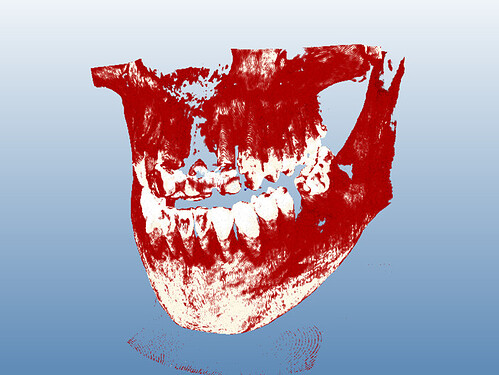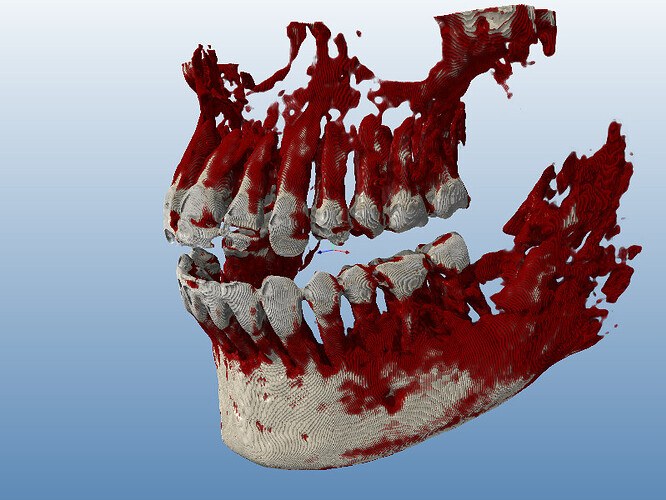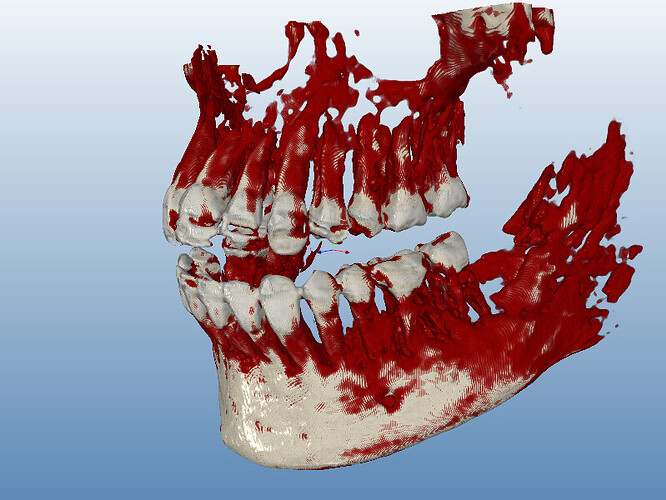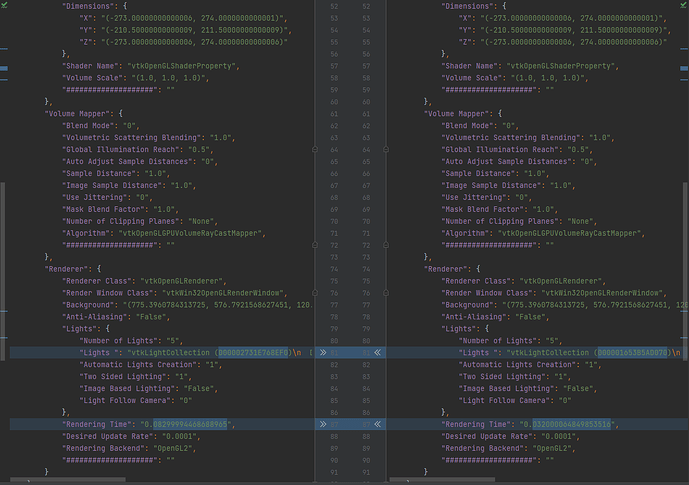Hello @sankhesh, thanks again for your fast reply. Hope you had a great weekend.
To check the data type, I have printed the data type and number of components in the lines where the transfer function is assigned to the volume property.
self.volume_property.SetTransferFunctionModeTo2D()
self.volume_property.SetTransferFunction2D(self.two_dimensional_tf)
print('#############################################')
print(' --> Transfer-Function-Datatype: ', type(self.two_dimensional_tf))
print(' --> Transfer-Function-Dimensions: ', self.two_dimensional_tf.GetDimensions())
print(' --> Transfer-Function-Komponents: ', self.two_dimensional_tf.GetNumberOfScalarComponents())
With the following result:
#############################################
--> Transfer-Function-Datatype: <class 'vtkmodules.vtkCommonDataModel.vtkImageData'>
--> Transfer-Function-Dimensions: (256, 256, 1)
--> Transfer-Function-Komponents: 4
#############################################
So the Datatype should be correct. Below you can see the entire error message from the vtkOutputWindow
ERROR: In vtkShaderProgram.cxx, line 452
vtkShaderProgram (0000023F57F066F0): 1: #version 150
2: #ifdef GL_ES
3: #ifdef GL_FRAGMENT_PRECISION_HIGH
4: precision highp float;
5: precision highp sampler2D;
6: precision highp sampler3D;
7: #else
8: precision mediump float;
9: precision mediump sampler2D;
10: precision mediump sampler3D;
11: #endif
12: #define texelFetchBuffer texelFetch
13: #define texture1D texture
14: #define texture2D texture
15: #define texture3D texture
16: #else // GL_ES
17: #define highp
18: #define mediump
19: #define lowp
20: #if __VERSION__ == 150
21: #define texelFetchBuffer texelFetch
22: #define texture1D texture
23: #define texture2D texture
24: #define texture3D texture
25: #endif
26: #endif // GL_ES
27: #define varying in
28:
29:
30: /*=========================================================================
31:
32: Program: Visualization Toolkit
33: Module: raycasterfs.glsl
34:
35: Copyright (c) Ken Martin, Will Schroeder, Bill Lorensen
36: All rights reserved.
37: See Copyright.txt or http://www.kitware.com/Copyright.htm for details.
38:
39: This software is distributed WITHOUT ANY WARRANTY; without even
40: the implied warranty of MERCHANTABILITY or FITNESS FOR A PARTICULAR
41: PURPOSE. See the above copyright notice for more information.
42:
43: =========================================================================*/
44:
45: //////////////////////////////////////////////////////////////////////////////
46: ///
47: /// Inputs
48: ///
49: //////////////////////////////////////////////////////////////////////////////
50:
51: /// 3D texture coordinates form vertex shader
52: in vec3 ip_textureCoords;
53: in vec3 ip_vertexPos;
54:
55: //////////////////////////////////////////////////////////////////////////////
56: ///
57: /// Outputs
58: ///
59: //////////////////////////////////////////////////////////////////////////////
60:
61: vec4 g_fragColor = vec4(0.0);
62:
63: //////////////////////////////////////////////////////////////////////////////
64: ///
65: /// Uniforms, attributes, and globals
66: ///
67: //////////////////////////////////////////////////////////////////////////////
68: vec3 g_dirStep;
69: float g_lengthStep = 0.0;
70: vec4 g_srcColor;
71: vec4 g_eyePosObj;
72: bool g_exit;
73: bool g_skip;
74: float g_currentT;
75: float g_terminatePointMax;
76:
77: // These describe the entire ray for this scene, not just the current depth
78: // peeling segment. These are texture coordinates.
79: vec3 g_rayOrigin; // Entry point of volume or clip point
80: vec3 g_rayTermination; // Termination point (depth, clip, etc)
81:
82: // These describe the current segment. If not peeling, they are initialized to
83: // the ray endpoints.
84: vec3 g_dataPos;
85: vec3 g_terminatePos;
86:
87: float g_jitterValue = 0.0;
88:
89:
90:
91: out vec4 fragOutput0;
92:
93:
94: uniform sampler3D in_volume[1];
95: uniform vec4 in_volume_scale[1];
96: uniform vec4 in_volume_bias[1];
97: uniform int in_noOfComponents;
98:
99: uniform sampler2D in_depthSampler;
100:
101: // Camera position
102: uniform vec3 in_cameraPos;
103: uniform mat4 in_volumeMatrix[1];
104: uniform mat4 in_inverseVolumeMatrix[1];
105: uniform mat4 in_textureDatasetMatrix[1];
106: uniform mat4 in_inverseTextureDatasetMatrix[1];
107: uniform mat4 in_textureToEye[1];
108: uniform vec3 in_texMin[1];
109: uniform vec3 in_texMax[1];
110: uniform mat4 in_cellToPoint[1];
111: // view and model matrices
112: uniform mat4 in_projectionMatrix;
113: uniform mat4 in_inverseProjectionMatrix;
114: uniform mat4 in_modelViewMatrix;
115: uniform mat4 in_inverseModelViewMatrix;
116: in mat4 ip_inverseTextureDataAdjusted;
117:
118: // Ray step size
119: uniform vec3 in_cellStep[1];
120: mat4 g_eyeToTexture = in_inverseTextureDatasetMatrix[0] * in_inverseVolumeMatrix[0] * in_inverseModelViewMatrix;
121: mat4 g_texToView = in_modelViewMatrix * in_volumeMatrix[0] *in_textureDatasetMatrix[0];
122: uniform vec2 in_scalarsRange[4];
123: uniform vec3 in_cellSpacing[1];
124:
125: // Sample distance
126: uniform float in_sampleDistance;
127:
128: // Scales
129: uniform vec2 in_windowLowerLeftCorner;
130: uniform vec2 in_inverseOriginalWindowSize;
131: uniform vec2 in_inverseWindowSize;
132: uniform vec3 in_textureExtentsMax;
133: uniform vec3 in_textureExtentsMin;
134:
135: // Material and lighting
136: uniform vec3 in_diffuse[4];
137: uniform vec3 in_ambient[4];
138: uniform vec3 in_specular[4];
139: uniform float in_shininess[4];
140:
141: // Others
142: vec3 g_rayJitter = vec3(0.0);
143:
144: uniform vec2 in_averageIPRange;
145: vec4 g_eyePosObjs[1];
146: uniform bool in_twoSidedLighting;
147:
148: uniform float in_giReach;
149: uniform float in_anisotropy;
150: uniform float in_volumetricScatteringBlending;
151:
152: #define TOTAL_NUMBER_LIGHTS 5
153: #define NUMBER_POS_LIGHTS 0
154: vec4 g_fragWorldPos;
155: uniform vec3 in_lightAmbientColor[TOTAL_NUMBER_LIGHTS];
156: uniform vec3 in_lightDiffuseColor[TOTAL_NUMBER_LIGHTS];
157: uniform vec3 in_lightSpecularColor[TOTAL_NUMBER_LIGHTS];
158: uniform vec3 in_lightDirection[TOTAL_NUMBER_LIGHTS];
159: vec3 g_lightDirectionTex[TOTAL_NUMBER_LIGHTS];
160:
161:
162: const float g_opacityThreshold = 1.0 - 1.0 / 255.0;
163:
164:
165:
166:
167:
168: #define EPSILON 0.001
169:
170: // Computes the intersection between a ray and a box
171: // The box should be axis aligned so we only give two arguments
172: struct Hit
173: {
174: float tmin;
175: float tmax;
176: };
177:
178: struct Ray
179: {
180: vec3 origin;
181: vec3 dir;
182: vec3 invDir;
183: };
184:
185: bool BBoxIntersect(const vec3 boxMin, const vec3 boxMax, const Ray r, out Hit hit)
186: {
187: vec3 tbot = r.invDir * (boxMin - r.origin);
188: vec3 ttop = r.invDir * (boxMax - r.origin);
189: vec3 tmin = min(ttop, tbot);
190: vec3 tmax = max(ttop, tbot);
191: vec2 t = max(tmin.xx, tmin.yz);
192: float t0 = max(t.x, t.y);
193: t = min(tmax.xx, tmax.yz);
194: float t1 = min(t.x, t.y);
195: hit.tmin = t0;
196: hit.tmax = t1;
197: return t1 > max(t0, 0.0);
198: }
199:
200: // As BBoxIntersect requires the inverse of the ray coords,
201: // this function is used to avoid numerical issues
202: void safe_0_vector(inout Ray ray)
203: {
204: if(abs(ray.dir.x) < EPSILON) ray.dir.x = sign(ray.dir.x) * EPSILON;
205: if(abs(ray.dir.y) < EPSILON) ray.dir.y = sign(ray.dir.y) * EPSILON;
206: if(abs(ray.dir.z) < EPSILON) ray.dir.z = sign(ray.dir.z) * EPSILON;
207: }
208:
209: // the phase function should be normalized to 4pi for compatibility with surface rendering
210:
211: float phase_function(float cos_angle)
212: {
213: return 1.0;
214: }
215:
216:
217:
218:
219:
220:
221:
222:
223:
224:
225: vec4 g_gradients_0[1];
226:
227:
228: uniform sampler2D in_transfer2D_0[1];
229: uniform sampler3D in_transfer2DYAxis;
230: uniform vec4 in_transfer2DYAxis_scale;
231: uniform vec4 in_transfer2DYAxis_bias;
232:
233:
234: //VTK::ComputeGradientOpacity1D::Dec
235:
236: float computeOpacity(vec4 scalar)
237: {
238: return texture2D(in_transfer2D_0[0],
239: vec2(scalar.a, g_gradients_0[0].w)).a;
240: }
241:
242:
243: vec4 computeRGBAWithGrad(vec4 scalar, vec4 grad)
244: {
245: return texture2D(in_transfer2D_0[0],
246: vec2(scalar.a, grad.w));
247: }
248:
249:
250: // c is short for component
251: vec4 computeGradient(in vec3 texPos, in int c, in sampler3D volume,in int index)
252: {
253: // Approximate Nabla(F) derivatives with central differences.
254: vec3 g1; // F_front
255: vec3 g2; // F_back
256: vec3 xvec = vec3(in_cellStep[index].x, 0.0, 0.0);
257: vec3 yvec = vec3(0.0, in_cellStep[index].y, 0.0);
258: vec3 zvec = vec3(0.0, 0.0, in_cellStep[index].z);
259: vec3 texPosPvec[3];
260: texPosPvec[0] = texPos + xvec;
261: texPosPvec[1] = texPos + yvec;
262: texPosPvec[2] = texPos + zvec;
263: vec3 texPosNvec[3];
264: texPosNvec[0] = texPos - xvec;
265: texPosNvec[1] = texPos - yvec;
266: texPosNvec[2] = texPos - zvec;
267: g1.x = texture3D(volume, vec3(texPosPvec[0]))[c];
268: g1.y = texture3D(volume, vec3(texPosPvec[1]))[c];
269: g1.z = texture3D(volume, vec3(texPosPvec[2]))[c];
270: g2.x = texture3D(volume, vec3(texPosNvec[0]))[c];
271: g2.y = texture3D(volume, vec3(texPosNvec[1]))[c];
272: g2.z = texture3D(volume, vec3(texPosNvec[2]))[c];
273:
274: // Apply scale and bias to the fetched values.
275: g1 = g1 * in_volume_scale[index][c] + in_volume_bias[index][c];
276: g2 = g2 * in_volume_scale[index][c] + in_volume_bias[index][c];
277:
278: // Scale values the actual scalar range.
279: float range = in_scalarsRange[4*index+c][1] - in_scalarsRange[4*index+c][0];
280: g1 = in_scalarsRange[4*index+c][0] + range * g1;
281: g2 = in_scalarsRange[4*index+c][0] + range * g2;
282:
283: // Central differences: (F_front - F_back) / 2h
284: g2 = g1 - g2;
285:
286: float avgSpacing = (in_cellSpacing[index].x +
287: in_cellSpacing[index].y + in_cellSpacing[index].z) / 3.0;
288: vec3 aspect = in_cellSpacing[index] * 2.0 / avgSpacing;
289: g2 /= aspect;
290: float grad_mag = length(g2);
291:
292: // Handle normalizing with grad_mag == 0.0
293: g2 = grad_mag > 0.0 ? normalize(g2) : vec3(0.0);
294:
295: // Since the actual range of the gradient magnitude is unknown,
296: // assume it is in the range [0, 0.25 * dataRange].
297: range = range != 0 ? range : 1.0;
298: grad_mag = grad_mag / (0.25 * range);
299: grad_mag = clamp(grad_mag, 0.0, 1.0);
300:
301: return vec4(g2.xyz, grad_mag);
302: }
303:
304:
305: //VTK::ComputeDensityGradient::Dec
306:
307: float volumeShadow(vec3 sample_position, vec3 light_pos_dir, float is_Pos, in int c, in sampler3D volume, int index, float label)
308: {
309:
310: float shadow = 1.0;
311: vec3 direction = vec3(0.0);
312: vec3 norm_dir = vec3(0.0);
313: float maxdist = 0.0;
314: float scalar;
315: vec4 gradient;
316: float opacity = 0.0;
317: vec3 color;
318: Ray ray;
319: Hit hit;
320: float sampled_dist = 0.0;
321: vec3 sampled_point = vec3(0.0);
322:
323: // direction is light_pos_dir when light is directional
324: // and light_pos_dir - sample_position when positional
325: direction = light_pos_dir - is_Pos * sample_position;
326: norm_dir = normalize(direction);
327: // introduce little offset to avoid sampling shadows at the exact
328: // sample position
329: sample_position += g_lengthStep * norm_dir;
330: direction = light_pos_dir - is_Pos * sample_position;
331: ray.origin = sample_position;
332: ray.dir = norm_dir;
333: safe_0_vector(ray);
334: ray.invDir = 1.0/ray.dir;
335: if(!BBoxIntersect(vec3(0.0), vec3(1.0), ray, hit))
336: {
337: // it can happen around the bounding box
338: return 1.0;
339: }
340: if(hit.tmax < g_lengthStep)
341: {
342: // if we're too close to the bounding box
343: return 1.0;
344: }
345: // in case of directional light, we want direction not to be normalized but to go
346: // all the way to the bbox
347: direction *= pow(hit.tmax / length(direction), 1.0 - is_Pos);
348: maxdist = min(hit.tmax, length(direction));
349: maxdist = min(in_giReach, maxdist);
350: if(maxdist < EPSILON) return 1.0;
351:
352:
353: float current_dist = 0.0;
354: float current_step = g_lengthStep;
355: float clamped_step = 0.0;
356: while(current_dist < maxdist)
357: {
358: clamped_step = min(maxdist - current_dist, current_step);
359: sampled_dist = current_dist + clamped_step * g_jitterValue;
360: sampled_point = sample_position + sampled_dist * norm_dir;
361: scalar = texture3D(volume, sampled_point)[c];
362: scalar = scalar * in_volume_scale[index][c] + in_volume_bias[index][c];
363: gradient = computeGradient(sampled_point, c, volume, index);
364: vec4 lutRes = computeRGBAWithGrad(vec4(scalar), gradient);
365: opacity = lutRes.a;
366: color = lutRes.xyz
367:
368: shadow *= 1.0 - opacity;
369: current_dist += current_step;
370: }
371: return shadow;
372: }
373:
374:
375:
376: vec4 computeLighting(vec4 color, int component, float label)
377: {
378: vec4 finalColor = vec4(0.0);
379: vec4 shading_gradient = computeGradient(g_dataPos, component, in_volume[0], 0);
380: vec4 gradient = shading_gradient;
381:
382: g_fragWorldPos = g_texToView * vec4(g_dataPos, 1.0);
383: if (g_fragWorldPos.w != 0.0)
384: {
385: g_fragWorldPos /= g_fragWorldPos.w;
386: }
387: vec3 viewDirection = normalize(-g_fragWorldPos.xyz);
388: vec3 ambient = vec3(0,0,0);
389: vec3 diffuse = vec3(0,0,0);
390: vec3 specular = vec3(0,0,0);
391: vec3 vertLightDirection;
392: vec3 normal = normalize((in_textureToEye[0] * vec4(shading_gradient.xyz, 0.0)).xyz);
393: vec3 lightDir;
394:
395: for (int dirNum = NUMBER_POS_LIGHTS; dirNum < TOTAL_NUMBER_LIGHTS; dirNum++)
396: {
397: vertLightDirection = in_lightDirection[dirNum];
398: float nDotL = dot(normal, vertLightDirection);
399: if (nDotL < 0.0 && in_twoSidedLighting)
400: {
401: nDotL = -nDotL;
402: }
403: if (nDotL > 0.0)
404: {
405: float df = max(0.0, nDotL);
406: diffuse += (df * in_lightDiffuseColor[dirNum]);
407: vec3 r = normalize(2.0 * nDotL * normal - vertLightDirection);
408: float rDotV = dot(-viewDirection, r);
409: if (rDotV > 0.0)
410: {
411: float sf = pow(rDotV, in_shininess[component]);
412: specular += (sf * in_lightSpecularColor[dirNum]);
413: }
414: }
415: ambient += in_lightAmbientColor[dirNum];
416: }
417: finalColor.xyz = in_ambient[component] * ambient +
418: in_diffuse[component] * diffuse * color.rgb +
419: in_specular[component] * specular;
420:
421: vec3 view_tdir = normalize((g_eyeToTexture * vec4(viewDirection, 0.0)).xyz);
422:
423: vec3 secondary_contrib = vec3(0.0);
424: vec3 tex_light = vec3(0.0);
425: shading_gradient.w = length(shading_gradient.xyz);
426: vec3 diffuse_light = vec3(0.0);
427: float attenuation = 0.0;
428: float vol_shadow = 0.0;
429: float phase = 1.0;
430:
431: for(int dirNum = NUMBER_POS_LIGHTS; dirNum < TOTAL_NUMBER_LIGHTS; dirNum++)
432: {
433: tex_light = g_lightDirectionTex[dirNum];
434: phase = phase_function(dot(normalize(-tex_light), view_tdir));
435: vol_shadow = volumeShadow(g_dataPos, tex_light, 0.0, component, in_volume[0], 0, label);
436: secondary_contrib += vol_shadow * phase * color.rgb * in_diffuse[component] * in_lightDiffuseColor[dirNum];
437: secondary_contrib += in_ambient[component] * in_lightAmbientColor[dirNum];
438: }
439: float vol_coef = 2.0 * in_volumetricScatteringBlending * exp( - 2.0 * in_volumetricScatteringBlending * shading_gradient.w * color.a);
440:
441: finalColor.xyz = (1.0 - vol_coef) * finalColor.xyz + vol_coef * secondary_contrib;
442:
443: finalColor.a = color.a;
444: return finalColor;
445: }
446:
447: vec4 computeColor(vec4 scalar, float opacity)
448: {
449: vec4 color = texture2D(in_transfer2D_0[0],
450: vec2(scalar.w, g_gradients_0[0].w));
451: return computeLighting(color, 0, 0);
452: }
453:
454:
455:
456: vec3 computeRayDirection()
457: {
458: return normalize(ip_vertexPos.xyz - g_eyePosObj.xyz);
459: }
460:
461: //VTK::Picking::Dec
462:
463: //VTK::RenderToImage::Dec
464:
465: //VTK::DepthPeeling::Dec
466:
467: uniform float in_scale;
468: uniform float in_bias;
469:
470: //////////////////////////////////////////////////////////////////////////////
471: ///
472: /// Helper functions
473: ///
474: //////////////////////////////////////////////////////////////////////////////
475:
476: /**
477: * Transform window coordinate to NDC.
478: */
479: vec4 WindowToNDC(const float xCoord, const float yCoord, const float zCoord)
480: {
481: vec4 NDCCoord = vec4(0.0, 0.0, 0.0, 1.0);
482:
483: NDCCoord.x = (xCoord - in_windowLowerLeftCorner.x) * 2.0 *
484: in_inverseWindowSize.x - 1.0;
485: NDCCoord.y = (yCoord - in_windowLowerLeftCorner.y) * 2.0 *
486: in_inverseWindowSize.y - 1.0;
487: NDCCoord.z = (2.0 * zCoord - (gl_DepthRange.near + gl_DepthRange.far)) /
488: gl_DepthRange.diff;
489:
490: return NDCCoord;
491: }
492:
493: /**
494: * Transform NDC coordinate to window coordinates.
495: */
496: vec4 NDCToWindow(const float xNDC, const float yNDC, const float zNDC)
497: {
498: vec4 WinCoord = vec4(0.0, 0.0, 0.0, 1.0);
499:
500: WinCoord.x = (xNDC + 1.f) / (2.f * in_inverseWindowSize.x) +
501: in_windowLowerLeftCorner.x;
502: WinCoord.y = (yNDC + 1.f) / (2.f * in_inverseWindowSize.y) +
503: in_windowLowerLeftCorner.y;
504: WinCoord.z = (zNDC * gl_DepthRange.diff +
505: (gl_DepthRange.near + gl_DepthRange.far)) / 2.f;
506:
507: return WinCoord;
508: }
509:
510: /**
511: * Clamps the texture coordinate vector @a pos to a new position in the set
512: * { start + i * step }, where i is an integer. If @a ceiling
513: * is true, the sample located further in the direction of @a step is used,
514: * otherwise the sample location closer to the eye is used.
515: * This function assumes both start and pos already have jittering applied.
516: */
517: vec3 ClampToSampleLocation(vec3 start, vec3 step, vec3 pos, bool ceiling)
518: {
519: vec3 offset = pos - start;
520: float stepLength = length(step);
521:
522: // Scalar projection of offset on step:
523: float dist = dot(offset, step / stepLength);
524: if (dist < 0.) // Don't move before the start position:
525: {
526: return start;
527: }
528:
529: // Number of steps
530: float steps = dist / stepLength;
531:
532: // If we're reeaaaaallly close, just round -- it's likely just numerical noise
533: // and the value should be considered exact.
534: if (abs(mod(steps, 1.)) > 1e-5)
535: {
536: if (ceiling)
537: {
538: steps = ceil(steps);
539: }
540: else
541: {
542: steps = floor(steps);
543: }
544: }
545: else
546: {
547: steps = floor(steps + 0.5);
548: }
549:
550: return start + steps * step;
551: }
552:
553: //////////////////////////////////////////////////////////////////////////////
554: ///
555: /// Ray-casting
556: ///
557: //////////////////////////////////////////////////////////////////////////////
558:
559: /**
560: * Global initialization. This method should only be called once per shader
561: * invocation regardless of whether castRay() is called several times (e.g.
562: * vtkDualDepthPeelingPass). Any castRay() specific initialization should be
563: * placed within that function.
564: */
565: void initializeRayCast()
566: {
567: /// Initialize g_fragColor (output) to 0
568: g_fragColor = vec4(0.0);
569: g_dirStep = vec3(0.0);
570: g_srcColor = vec4(0.0);
571: g_exit = false;
572:
573:
574: // Get the 3D texture coordinates for lookup into the in_volume dataset
575: g_rayOrigin = ip_textureCoords.xyz;
576:
577: // Eye position in dataset space
578: g_eyePosObj = in_inverseVolumeMatrix[0] * vec4(in_cameraPos, 1.0);
579: g_eyePosObjs[0] = in_inverseVolumeMatrix[0] * vec4(in_cameraPos, 1.0);
580:
581: // Getting the ray marching direction (in dataset space)
582: vec3 rayDir = computeRayDirection();
583:
584: // 2D Texture fragment coordinates [0,1] from fragment coordinates.
585: // The frame buffer texture has the size of the plain buffer but
586: // we use a fraction of it. The texture coordinate is less than 1 if
587: // the reduction factor is less than 1.
588: // Device coordinates are between -1 and 1. We need texture
589: // coordinates between 0 and 1. The in_depthSampler
590: // buffer has the original size buffer.
591: vec2 fragTexCoord = (gl_FragCoord.xy - in_windowLowerLeftCorner) *
592: in_inverseWindowSize;
593:
594: // Multiply the raymarching direction with the step size to get the
595: // sub-step size we need to take at each raymarching step
596: g_dirStep = (ip_inverseTextureDataAdjusted *
597: vec4(rayDir, 0.0)).xyz * in_sampleDistance;
598: g_lengthStep = length(g_dirStep);
599:
600: float jitterValue = 0.0;
601:
602: g_rayJitter = g_dirStep;
603:
604: g_rayOrigin += g_rayJitter;
605:
606: // Flag to determine if voxel should be considered for the rendering
607: g_skip = false;
608:
609:
610:
611:
612: // Flag to indicate if the raymarch loop should terminate
613: bool stop = false;
614:
615: g_terminatePointMax = 0.0;
616:
617: vec4 l_depthValue = texture2D(in_depthSampler, fragTexCoord);
618: // Depth test
619: if(gl_FragCoord.z >= l_depthValue.x)
620: {
621: discard;
622: }
623:
624: // color buffer or max scalar buffer have a reduced size.
625: fragTexCoord = (gl_FragCoord.xy - in_windowLowerLeftCorner) *
626: in_inverseOriginalWindowSize;
627:
628: // Compute max number of iterations it will take before we hit
629: // the termination point
630:
631: // Abscissa of the point on the depth buffer along the ray.
632: // point in texture coordinates
633: vec4 rayTermination = WindowToNDC(gl_FragCoord.x, gl_FragCoord.y, l_depthValue.x);
634:
635: // From normalized device coordinates to eye coordinates.
636: // in_projectionMatrix is inversed because of way VT
637: // From eye coordinates to texture coordinates
638: rayTermination = ip_inverseTextureDataAdjusted *
639: in_inverseVolumeMatrix[0] *
640: in_inverseModelViewMatrix *
641: in_inverseProjectionMatrix *
642: rayTermination;
643: g_rayTermination = rayTermination.xyz / rayTermination.w;
644:
645: // Setup the current segment:
646: g_dataPos = g_rayOrigin;
647: g_terminatePos = g_rayTermination;
648:
649: g_terminatePointMax = length(g_terminatePos.xyz - g_dataPos.xyz) /
650: length(g_dirStep);
651: g_currentT = 0.0;
652:
653:
654:
655: //VTK::RenderToImage::Init
656:
657: //VTK::DepthPass::Init
658:
659:
660: for(int i=0; i<TOTAL_NUMBER_LIGHTS; i++)
661: {
662: g_lightDirectionTex[i] = (g_eyeToTexture * vec4(-in_lightDirection[i], 0.0)).xyz;
663: }
664:
665:
666: g_jitterValue = jitterValue;
667: }
668:
669: /**
670: * March along the ray direction sampling the volume texture. This function
671: * takes a start and end point as arguments but it is up to the specific render
672: * pass implementation to use these values (e.g. vtkDualDepthPeelingPass). The
673: * mapper does not use these values by default, instead it uses the number of
674: * steps defined by g_terminatePointMax.
675: */
676: vec4 castRay(const float zStart, const float zEnd)
677: {
678: //VTK::DepthPeeling::Ray::Init
679:
680:
681:
682: //VTK::DepthPeeling::Ray::PathCheck
683:
684:
685:
686: /// For all samples along the ray
687: while (!g_exit)
688: {
689:
690: g_skip = false;
691:
692:
693:
694:
695:
696:
697:
698: g_gradients_0[0] = computeGradient(g_dataPos, 0, in_volume[0], 0);
699:
700:
701:
702: if (!g_skip)
703: {
704: vec4 scalar;
705:
706: scalar = texture3D(in_volume[0], g_dataPos);
707:
708: scalar.r = scalar.r * in_volume_scale[0].r + in_volume_bias[0].r;
709: scalar = vec4(scalar.r);
710: g_srcColor = vec4(0.0);
711: g_srcColor.a = computeOpacity(scalar);
712: if (g_srcColor.a > 0.0)
713: {
714: g_srcColor = computeColor(scalar, g_srcColor.a);
715: // Opacity calculation using compositing:
716: // Here we use front to back compositing scheme whereby
717: // the current sample value is multiplied to the
718: // currently accumulated alpha and then this product
719: // is subtracted from the sample value to get the
720: // alpha from the previous steps. Next, this alpha is
721: // multiplied with the current sample colour
722: // and accumulated to the composited colour. The alpha
723: // value from the previous steps is then accumulated
724: // to the composited colour alpha.
725: g_srcColor.rgb *= g_srcColor.a;
726: g_fragColor = (1.0f - g_fragColor.a) * g_srcColor + g_fragColor;
727: }
728: }
729:
730: //VTK::RenderToImage::Impl
731:
732: //VTK::DepthPass::Impl
733:
734: /// Advance ray
735: g_dataPos += g_dirStep;
736:
737:
738: if(any(greaterThan(max(g_dirStep, vec3(0.0))*(g_dataPos - in_texMax[0]),vec3(0.0))) ||
739: any(greaterThan(min(g_dirStep, vec3(0.0))*(g_dataPos - in_texMin[0]),vec3(0.0))))
740: {
741: break;
742: }
743:
744: // Early ray termination
745: // if the currently composited colour alpha is already fully saturated
746: // we terminated the loop or if we have hit an obstacle in the
747: // direction of they ray (using depth buffer) we terminate as well.
748: if((g_fragColor.a > g_opacityThreshold) ||
749: g_currentT >= g_terminatePointMax)
750: {
751: break;
752: }
753: ++g_currentT;
754: }
755:
756:
757:
758: return g_fragColor;
759: }
760:
761: /**
762: * Finalize specific modes and set output data.
763: */
764: void finalizeRayCast()
765: {
766:
767:
768:
769:
770:
771:
772:
773:
774: //VTK::Picking::Exit
775:
776: g_fragColor.r = g_fragColor.r * in_scale + in_bias * g_fragColor.a;
777: g_fragColor.g = g_fragColor.g * in_scale + in_bias * g_fragColor.a;
778: g_fragColor.b = g_fragColor.b * in_scale + in_bias * g_fragColor.a;
779: fragOutput0 = g_fragColor;
780:
781: //VTK::RenderToImage::Exit
782:
783: //VTK::DepthPass::Exit
784: }
785:
786: //////////////////////////////////////////////////////////////////////////////
787: ///
788: /// Main
789: ///
790: //////////////////////////////////////////////////////////////////////////////
791: void main()
792: {
793:
794: initializeRayCast();
795: castRay(-1.0, -1.0);
796: finalizeRayCast();
797: }
ERROR: In vtkShaderProgram.cxx, line 453
vtkShaderProgram (0000023F57F066F0): 0(368) : error C0000: syntax error, unexpected identifier, expecting ',' or ';' at token "shadow"
ERROR: In vtkOpenGLGPUVolumeRayCastMapper.cxx, line 2833
vtkOpenGLGPUVolumeRayCastMapper (0000023F579EBDE0): Shader failed to compile





